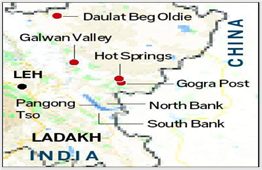In News:
- Recently, the 17th round of the corps-commander-level meeting was held at the Chushul-Moldo border meeting point on the Chinese side.
- The meeting saw India pressing China for early and complete disengagement at the remaining friction points, including in Demchok and Depsang.
What’s in Today’s Article:
- Previous rounds of talks (background, corps commander level talks, outcome of the previous rounds)
- News summary
Background

- In May 2020, Indian and Chinese troops clashed at various points along the Line of Actual Control (LAC).
- These points included:
- Pangong Tso, Galwan Nalah and Demchok in Ladakh and at Naku La (a mountain pass at an altitude of over 5000 metres) in Sikkim.
- Later, a violent clash at Galwan Valley started between Indian troops and soldiers of the People's Liberation Army (PLA) on the night of June 15, 2020.
- It was the first deadly clash between India and China in at least 45 years. 20 Indian soldiers lost their lives.
- After this incident, both sides deployed a large number of troops in the area along with heavy weaponry.
- The infrastructure build-up has also been very heavy and the standoff between the two forces is continuing.
The Corps Commander level talks
- India and China have been holding the talks on the Line of Actual Control (LAC) in Eastern Ladakh area to resolve the standoff.
- Earlier to the current talk, the 16 round of Corps Commander-level talks had been held between the two countries.
- The 16th round took place in July 2022.
Outcomes of the previous rounds of talks
- Troops were disengaged on the north and south banks of Pangong Tso and Gogra Post.
- However, at Hot Springs they continue to face each other.
- China had refused to complete the stalled troop disengagement at the Patrolling Point (PP) – 15 in the Hot Springs-Gogra-Kongka La area.
- The Chinese have also been preventing Indian troops from accessing five traditional patrolling points on the Depsang Plains.
- These five traditional patrolling are —PP10, PP11, PP11A, PP12 and PP13.
- Depsang plains are not far from the strategic Indian outpost at Daulat Beg Oldie near the Karakoram Pass in the north.
- The no-patrol buffer zones have been created after disengagement at
- PP-14 in Galwan Valley,
- PP-17A near Gogra
- Pangong Tso
- However, these zones have largely come up in what India claims to be its territory.
News Summary
- Military commanders from India & China held a fresh round of high-level talks in order to resolve the remaining issues along the Line of Actual Control in eastern Ladakh.
- During the meeting, India pressed China for early and complete disengagement at the remaining friction points, including in Demchok and Depsang.
- India maintained that disengagement, followed by de-escalation, is essential for bilateral ties to return to normal.
- China, however, believes the border situation in eastern Ladakh is no longer as serious as it was in 2020, when the military stand-off started, and wants to resume bilateral exchanges.
- However, there was no sign of any breakthrough in the talks.
- In a joint statement, issued after the meeting, they agreed to maintain security and stability in the western sector.
- They also decided to maintain dialogue for a mutually acceptable resolution of the remaining issues at the earliest.










